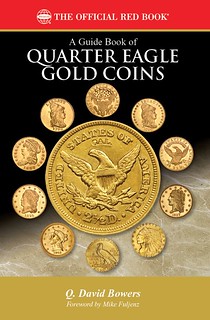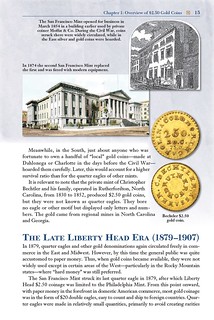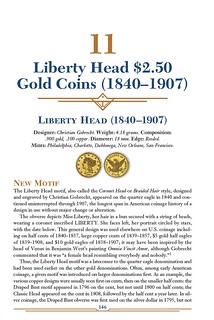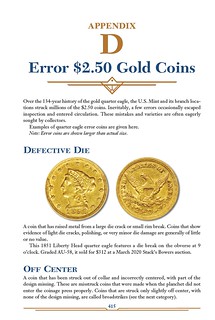
PREV ARTICLE
NEXT ARTICLE
FULL ISSUE
PREV FULL ISSUE
V25 2022 INDEX E-SYLUM ARCHIVE IN APPRECIATION OF QUARTER EAGLE GOLD COINSThis press release from Whitman Publishing describes the story behind the creation of the new Bowers book on Quarter Eagles. -Editor The latest Whitman Publishing book by Q. David Bowers will debut in March 2022. The 448-page Guide Book of Quarter Eagle Gold Coins will be available from bookstores and hobby shops and online (including at Whitman.com), and in the meantime is available for preorder. Here, Whitman publisher Dennis Tucker describes how the book came to be, and why it was undertaken in the first place.
Dave became a professional numismatist and coin dealer in the 1950s, when he was a young teenager. Back then gold coins weren't often seen in the hobby community. In his local coin club, even the older members rarely brought them in for show-and-tell, or to sell. Since the 1930s, Great Depression–era orders had legally restricted Starting with the Bicentennial gold-medal program, Congress and the Treasury Department would tinker with mass-market distribution of federal gold products, including the trial-and-error exploration embodied by the American Arts Gold Medallions and, finally, the debut of the nation's first widely successful gold-bullion program, the American Eagle coinage of 1986 to date. Today, Americans find it easier than ever to buy, sell, and trade gold coins. This includes numismatic offerings such as commemoratives, Proofs and Reverse Proofs, high-relief gold medals, and other collectibles. Classic pre-1934 U.S. gold coins, too, are now easy to study and collect. Many factors contribute to this.
A couple years ago I made an informal poll of 100 hobbyists. I found that roughly 10 percent identify themselves as
In the 1950s this level of interest and excitement over gold quarter eagles was nowhere to be seen. It was decades in the future. When Dave Bowers started in the hobby in the 1950s, books about gold coins were even rarer than the coins themselves. Researcher Walter Breen wrote a 24-page monograph on gold dollars in 1964. In 1975 numismatist David W. Akers, after spending more than 20 years researching gold coins (dollars in particular), published United States Gold Coins: An Analysis of Auction Records, Gold Dollars. Over the next seven years Akers compiled volumes covering every U.S. gold coin series. In the meantime Breen, too, continued to write monographs on other gold coins (up to the $10 denomination, published in 1967), and included gold coins in his two encyclopedias published in 1977 and 1988. Other writers over time added to the hobby community's knowledge of U.S. gold coins. Researchers published their work in Numismatic Scrapbook Magazine, Numismatic News, Coin World, The Numismatist, Coins Magazine, and other periodicals. Historian Cornelius Vermeule explored the aesthetics of U.S. coinage, including gold, in Numismatic Art in America (1971). Coin World published its Almanac in several editions starting in 1975, providing much technical information and data. Kenneth Bressett and others codified the grading of U.S. coins, including gold, in the Official American Numismatic Association Grading Standards for United States Coins (first edition, 1978). Later, Richard Doty, curator of the Smithsonian Institution's National Numismatic Collection, wrote his broad-ranging America's Money, America's Story, and Roger W. Burdette crafted his award-winning Renaissance of American Coinage books from deep study of the National Archives, Treasury records, and other primary sources. The gold coins of individual mints were covered by specialists including Rusty Goe (Carson City) and Douglas Winter (Carson City, Charlotte, Dahlonega, and New Orleans). Mike Fuljenz helped popularize U.S. gold coins with his award-winning books on various series. In the midst of this activity, Q. David Bowers emerged as the preeminent author on U.S. gold coinage—a position he holds to this day. Bowers's History of United States Coinage, As Illustrated by the Garrett Collection, published in 1979, included his analysis of the nation's gold coins. In 1982 he published United States Gold Coins: An Illustrated History. His numismatic history of collecting U.S. gold coins was released as part of the proceedings of the 1989 Coinage of the Americas Conference. In various other books of the 1990s and early 2000s, plus hundreds of articles and columns before and since, he's shared stories and insight on U.S. gold coins. In 2003 Bowers joined forces with Whitman Publishing, longtime publisher of the Red Book and other hobby books, signing on as the company's numismatic director. This collaboration has led to a boom in American book-publishing in the field of numismatics. Whitman publishes an average of one new book either entirely or substantially about gold coins every year, ranging from popular single-denomination guidebooks to (also popular) 650-page encyclopedias. The first came out in 2004: Bowers's Guide Book of Double Eagle Gold Coins was the first book to cover the entire spectrum of the $20 denomination since David Akers's 1982 volume on the subject. Among the more recent are Gold: Everything You Need to Know to Buy and Sell Today (by Bowers and Jeff Garrett, first published in 2010); Lost and Found Coin Hoards and Treasures: Illustrated Stories of the Greatest American Troves and Their Discoveries (Bowers, first edition 2015); and my own American Gold and Silver: U.S. Mint Collector and Investor Coins and Medals, Bicentennial to Date, published in 2016. As Whitman's numismatic director, Dave Bowers has advised on all of these books, while keeping up his own prodigious and constant research and writing.
David W. Akers, who in the 1970s and 1980s broke new ground publishing his numismatic research, has said, The Guide Book of Gold Quarter Eagle Coins—the 26th volume in the Bowers Series, and the 20th of those volumes written by Bowers himself—expands and confirms that distinction.
# # #
A Guide Book of Quarter Eagle Gold Coins, first edition.
And of course, don't forget Daryl Haynor's 2020 book, United States Classic Gold Coins of 1834-1839. -Editor
To read the earlier E-Sylum articles, see:
Wayne Homren, Editor The Numismatic Bibliomania Society is a non-profit organization promoting numismatic literature. See our web site at coinbooks.org. To submit items for publication in The E-Sylum, write to the Editor at this address: whomren@gmail.com To subscribe go to: https://my.binhost.com/lists/listinfo/esylum All Rights Reserved. NBS Home Page Contact the NBS webmaster 
|




